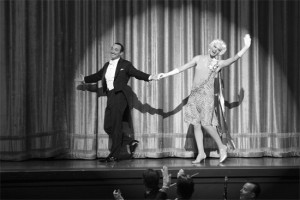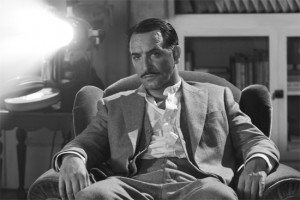The Artist: Making Silents Safe Again
Old techniques from the latest Oscar contender can change the way you look at modern movies
/https://tf-cmsv2-smithsonianmag-media.s3.amazonaws.com/filer/20111123102020Artist_Thumb.jpg)
For once the hype is accurate: The Artist is an honest-to-goodness black-and-white, silent, presented in the old-fashioned Academy aspect ratio instead of in widescreen. If you’ve never seen a silent movie, this is an excellent place to start. If you’re a buff, The Artist is a treasure trove of film references, in-jokes, pastiches, and references to filmmakers both famous and obscure. And if the Weinsteins apply the same media hammerlock that they used with Shakespeare in Love, this has a good chance of being the first silent to win any Oscar since Tabu 80 years ago.
We call them silent films today, but they were almost always accompanied by some form of music and sound effects. Thomas Edison originally thought of motion pictures as an adjunct to his phonograph, and his staff experimented with synchronized sound as early as 1895—you can see the results on the Library of Congress American Memory site.
The language or grammar of film that evolved from those days is still in use today: close-ups, cross-cutting, tracks and pans all would be familiar to early directors. But watching a silent film is different than watching a sound film. For one thing, you have to concentrate more—you have very little leeway, no opportunities to look away from the screen. You have to pay attention all the time. Characters make themselves known through action, not dialogue, so silent directors were always looking for bits of business or even costuming that would identify personality types quickly. Actors tended to be more physically expressive, with their hands and bodies, but also their smiles and grimaces.
Some look at silents as a more primitive form of talkies, but the best filmmakers achieved a connection with viewers that transcended the medium’s limitations. Directors like F.W. Murnau, Buster Keaton, Carl Dreyer, Jean Renoir made silence a part of their arsenal. Often their characters couldn’t talk, whether because of the situation they were in or their natural reticence. When newlyweds embark on their honeymoon in King Vidor’s The Crowd, their feelings are unmistakable, despite the absence of dialogue. Murnau’s The Last Laugh unfolds without any intertitles for dialogue at all.
Almost all of the great directors in the 1930s trained in silents, and if there is one distinguishing characteristic that unites artists as disparate as John Ford and Alfred Hitchcock, it is their ability to tell a story in purely visual terms. What is said in films like The Searchers or Psycho is important, but you don’t have to hear anything to understand the story.
Music was a crucial component in early silent film: it could color the emotions in a scene, enhance pacing, help identify characters and their motives. As the industry matured, prestige movies received elaborate scores that were delivered by full orchestras in first-run theaters. Even more modest films had cue sheets that recommended songs or musical themes for scenes.
The transition from silents to talkies at the end of the 1920s was short and painful. Careers were destroyed, techniques abandoned, subtleties lost. It took years for Hollywood to regain its artistic footing. Silents continued to be made well into the 1930s, usually due to economic considerations. Apart from the occasional stunt like Mel Brooks’ Silent Movie, “talkie” filmmakers tended to assimilate silent strategies in sound settings. The ending of Jules Dassin’s Topkapi is almost completely silent, for example. So is the opening of Pixar’s WALL-E, and a gorgeous montage detailing the lives of a married couple in Up.
In The Artist, director Michel Hazanavicius borrows liberally from several silent films and filmmakers, but he also cites such film classics as Singin’ in the Rain, A Star Is Born, Citizen Kane, and The Thin Man. In a sense, these references are short cuts, ways to set mood and atmosphere for viewers, to hand-hold them with familiar and popular story lines and characters while they adjust to watching a film without dialogue. By placing well-known moments from classic sound films into silent settings, Hazanavicius points out how closely the present is related to the past. The famous montage at the breakfast table in Citizen Kane, for example, where Kane’s marriage falls apart over a series of glances and changing newspaper headlines, is a silent sequence that Hazanavicius can rework effortlessly in The Artist.
The director took a similar approach in OSS 117: Cairo, Nest of Spies, a James Bond spoof that featured The Artist‘s leads Jean Dujardin and Bérénice Bejo. Entertaining but not earthshaking, OSS 117 and its sequel Lost in Rio were affectionate and respectful. If you like spy films, you might appreciate the jokes more than someone who’s never seen one.
In the same way, if you’ve seen Douglas Fairbanks movies, you’re in a better position to judge just how gracefully and winningly Dujardin imitates him. If you don’t know Fairbanks, you still know his type, and Hazanavicius gives you another “in” to the story by reminding you of Gene Kelly in Singin’ in the Rain.
Once you get past the stunt aspects of The Artist, you’re left with a story that often doesn’t make narrative sense, that turns morose and maudlin for much of its second half, that stints on Bejo’s character, and that lacks the kinetic action that marked the best silent comedies. The Artist is solidly middlebrow—entertaining, yes; well-made, certainly; but not the equal of the films it imitates. On the other hand, it’s not a turgid “masterpiece,” not an endless, portentous epic about the plight of mankind. It’s approachable, fun, undemanding, like a lot of mainstream movies from the silent era. Why not find out how enjoyable films like My Best Girl with Mary Pickford, or The Mark of Zorro with Fairbanks, or any of the shorts and features from the great comedians like Keaton, Charlie Chaplin, and Harold Lloyd, can be?
Despite the hopes of film buffs, I don’t think The Artist will inspire a rash of copycat silent features. But if it persuades at least some viewers that silents are nothing to be afraid of, and possibly even something to enjoy, it will have been worth the effort.
/https://tf-cmsv2-smithsonianmag-media.s3.amazonaws.com/accounts/headshot/daniel-eagan-240.jpg)


/https://tf-cmsv2-smithsonianmag-media.s3.amazonaws.com/accounts/headshot/daniel-eagan-240.jpg)